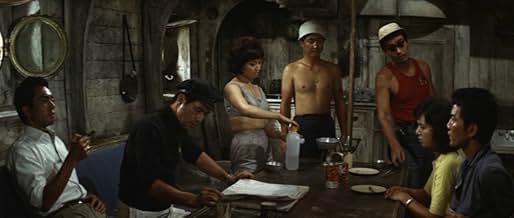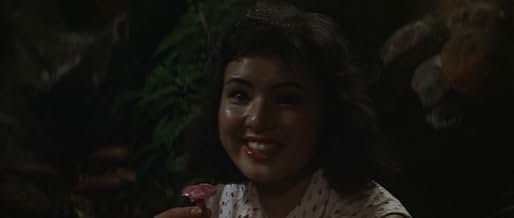IMDb-BEWERTUNG
6,4/10
3761
IHRE BEWERTUNG
Füge eine Handlung in deiner Sprache hinzuShipwrecked survivors slowly transform into mushrooms.Shipwrecked survivors slowly transform into mushrooms.Shipwrecked survivors slowly transform into mushrooms.
Takuzô Kumagai
- Doctor
- (as Jirô Kumagai)
Empfohlene Bewertungen
10Kabumpo
The cast of this film all consider it one of their proudest achievements. This film is about false friendships, utter hatred, and abandonment of values. Constructed from William Hope Hodgson's rather simple horror story, in which a man hailing a schooner for food tells how the virtuous (abstinent) unmarried couple (himself and his fiancee) were in a shipwreck and tried to make their home on an island encrusted with fungus, first in a ship and then in two tents on an unidentified sandy substance, only to eat the fungus and become it, takes on a whole new dimension by placing the man, here a psychology professor, and his student fiancee with a rich couple together only for the money, a serious writer, and the two-man crew. Though they never abandon the fungus-encrusted ship for tents, they soon become embittered over food, and the men all want the virgin, not the rich showgirl. Hodgson was on the way to becoming a minister before he was killed in WWI, and his story is explicitly Christian. This film takes out explicit religion (though the Japanese version has a brief scene related to Akiko's Shinto beliefs, which was deleted because most Americans wouldn't understand it), but retains the morals. The psychologist is unable to cope with the degrading values, particularly after the mate is shot over money (useless) and turtle eggs (food). The skipper takes the ship (which isn't his, Kasai wearing a captain's uniform to prove it (and how stuck up he is)) after repairing it, without anyone else, but he dies at sea, Murai soon finding the abandoned ship. The voyage reveals the true character of the relationships with one another, and their attempts to break down the virtuous couple, which ends with the psychologist in the asylum, where he tells his story. He gets succumbed, too. "My friends are alive; I'm the one who died," he tells them. The crew dead, his friends are left on the island, slowly merging with the fungus...
First a correction : the making year and distribution release year in Japan of MATANGO is 1962 and not 1963. It is of course a very good movie from Inoshiro Honda, the father of "Kaiju Eiga" and every cinephile knows what that means. Besides, it is a "Kaiju eiga" (= "monster movie" as trasnlated in English) quite closer to horror than to science-fiction, even it is also a sci-fi, including mentions of the atom research in the ghost boat in which the survivors are living. It is closer to BINJO TO EKITAI NINGEN [L'HOMME H] (Jap. 1958) than to GOJIRA (Jap. 1954), both directed by Honda, if you want to have a comparative idea. Anyway, it is a very original movie in Honda carrier. Even it can remind, as a cultivate reader mentionned it, a W.H.Hodgson's novel. But were the Japanese scriptwriters aware of that source ? Interesting question. I am glad to announce you that in France, a smart distributor has bought the rights from Toho and distributed that movie in a beautiful Cinemascope complying with 16/9 TV screening : it has been shown on Canal + private famous French TV but I do not think it is available on DVD or video.
It was around one or two years ago and we have been able to discover it in original japanese langage with French subtitles : beautiful master and beautiful movie. Honda is my favorite horror and sci-fi movie director with regard to history of Japanese movie. I have recently written an "Elementary filmography of Kaiju Eiga" in which Inoshiro Honda has of course the main place, as far as Toho is concerned. MATANGO is a masterpiece.
It was around one or two years ago and we have been able to discover it in original japanese langage with French subtitles : beautiful master and beautiful movie. Honda is my favorite horror and sci-fi movie director with regard to history of Japanese movie. I have recently written an "Elementary filmography of Kaiju Eiga" in which Inoshiro Honda has of course the main place, as far as Toho is concerned. MATANGO is a masterpiece.
Toho are mostly known for their dark bleak period pieces and their goofy monster flicks, but every once in a while they delved into something else and Matango is a great example of this.
Well ahead of its time it tells the story of ship wreck survivors trying to make it until help comes, but they don't appear to be alone on the island and tensions are beginning to build.
So okay I admit the concept is daft, the antagonists are a bit silly but lets be honest they aren't a million miles from those in The Last of Us (2013). Despite this they actually do the job quite well and look considerably better than you'd imagine considering this was the early 60's.
The film is a real slow burner and very little of it features the antagonists at all, the majority is the turmoil between survivors but it does this to a passable degree.
Though not everything it could have been there is a lot to be impressed over in Matango and it's a neat little forgotten Toho movie that deserves attention.
The Good:
Looks excellent for its time
Some good ideas
The Bad:
Cast and characters are pretty forgettable
Very slow burn
Things I Learnt From This Movie:
An opportune time to tell a woman you love her for the first time is straight after hitting her
Could easily have had a sequel about killer cheese people
Well ahead of its time it tells the story of ship wreck survivors trying to make it until help comes, but they don't appear to be alone on the island and tensions are beginning to build.
So okay I admit the concept is daft, the antagonists are a bit silly but lets be honest they aren't a million miles from those in The Last of Us (2013). Despite this they actually do the job quite well and look considerably better than you'd imagine considering this was the early 60's.
The film is a real slow burner and very little of it features the antagonists at all, the majority is the turmoil between survivors but it does this to a passable degree.
Though not everything it could have been there is a lot to be impressed over in Matango and it's a neat little forgotten Toho movie that deserves attention.
The Good:
Looks excellent for its time
Some good ideas
The Bad:
Cast and characters are pretty forgettable
Very slow burn
Things I Learnt From This Movie:
An opportune time to tell a woman you love her for the first time is straight after hitting her
Could easily have had a sequel about killer cheese people
First of all, if possible avoid the dubbed version of this one (ATTACK OF THE MUSHROOM PEOPLE). The dubbing is no worse than usual for a Japanese sci-fi/horror movie, but this one really needs the subtitles so the viewer won't be distracted by the cartoonish dubbed voices. There is an excellent widescreen/subtitled edition of this available from Video Daikaiju ( if they're still in business; they somehow got away with putting out excellent-quality subtitled versions of the films that Toho released for the Japanese video market), and it is also pretty easy to find at various comics/sci-fi/media conventions.
MATANGO scores very high on the slow-burn creepiness meter, and the story of a bunch of hapless castaways slowly descending in to distrust and madness is utterly compelling. What they find on the island is truly disturbing, and I can't put into words how thankful I am for not having seen this during my formative years. This is one of those movies that can royally mess up your mind if you're a little kid. HIGHLY RECOMMENDED.
MATANGO scores very high on the slow-burn creepiness meter, and the story of a bunch of hapless castaways slowly descending in to distrust and madness is utterly compelling. What they find on the island is truly disturbing, and I can't put into words how thankful I am for not having seen this during my formative years. This is one of those movies that can royally mess up your mind if you're a little kid. HIGHLY RECOMMENDED.
I have noticed that many of the commentators in this forum have stated that this film gave them nightmares. No wonder. This film based on William Hope Hodgson's novel "The Voice in the Night", has a plot that is so bizarre that it could only have been inspired by someone's nightmares. The premise of intelligent fungus luring people to eat them and then the people slowly turn to "mushroom people" is so nightmarishly creepy that I can't imagine that Hodgson (or anyone else) could of dreamed this idea up when he was wide awake.
MATANGO (aka ATTACK OF THE MUSHROOM PEOPLE) is a surprisingly low key atmospheric Japanese horror fantasy. The film is a bit slowly paced at times and too much time is spent on the castaways bickering amongst themselves. There are some elements that I suspect were better developed in the novel. One scene has the two female castaways hearing the voices of dead relatives trying to lure them into the rainforest. This never occurs again and leads nowhere. I'm sure the stuff about nuclear experiments was not in Hodgson's novel. However, the art direction is excellent, the music creepy and the final sequence memorable. Overall, the boys at Toho did a good job.
I don't care what the Medvids think of this film, or the pseudo hip MST3K crowd thinks either, your old pal jim says, see this one.
MATANGO (aka ATTACK OF THE MUSHROOM PEOPLE) is a surprisingly low key atmospheric Japanese horror fantasy. The film is a bit slowly paced at times and too much time is spent on the castaways bickering amongst themselves. There are some elements that I suspect were better developed in the novel. One scene has the two female castaways hearing the voices of dead relatives trying to lure them into the rainforest. This never occurs again and leads nowhere. I'm sure the stuff about nuclear experiments was not in Hodgson's novel. However, the art direction is excellent, the music creepy and the final sequence memorable. Overall, the boys at Toho did a good job.
I don't care what the Medvids think of this film, or the pseudo hip MST3K crowd thinks either, your old pal jim says, see this one.
Wusstest du schon
- WissenswertesThe film was nearly banned in Japan. The makeup some characters wore as they were turning into humanoid mushroom creatures was very similar to how many Japanese people looked after the atomic bombings of Hiroshima and Nagasaki.
- PatzerWhen Kasai shoots at Yoshida and Mami as he chases them off the boat, you can see the bullets ricochet off the ground before he even fires a shot.
- Crazy CreditsThe opening credits of the Japanese version are on animated sailboat sails.
- VerbindungenEdited into Gli ultimi giorni dell'umanità (2022)
Top-Auswahl
Melde dich zum Bewerten an und greife auf die Watchlist für personalisierte Empfehlungen zu.
- How long is Matango?Powered by Alexa
Details
- Erscheinungsdatum
- Herkunftsland
- Sprache
- Auch bekannt als
- Attack of the Mushroom People
- Drehorte
- Produktionsfirma
- Weitere beteiligte Unternehmen bei IMDbPro anzeigen
- Laufzeit1 Stunde 29 Minuten
- Sound-Mix
- Seitenverhältnis
- 2.55 : 1
Zu dieser Seite beitragen
Bearbeitung vorschlagen oder fehlenden Inhalt hinzufügen



























